Nursing Assessment and Priorities of Care for Pancreatitis Patient
VerifiedAdded on 2022/11/22
|8
|2963
|472
AI Summary
This essay is based on the case study of Mr. John Hayes, a 75 year old man who is suffering from pancreatitis. It covers the comprehensive nursing assessment, nursing interventions passed of the priorities of care within 1 to 2 hours post hospitalization, and discharge planning based on the social justice framework for health. The priorities of care include pain management, fluid resuscitation, and resting gut.
Contribute Materials
Your contribution can guide someone’s learning journey. Share your
documents today.
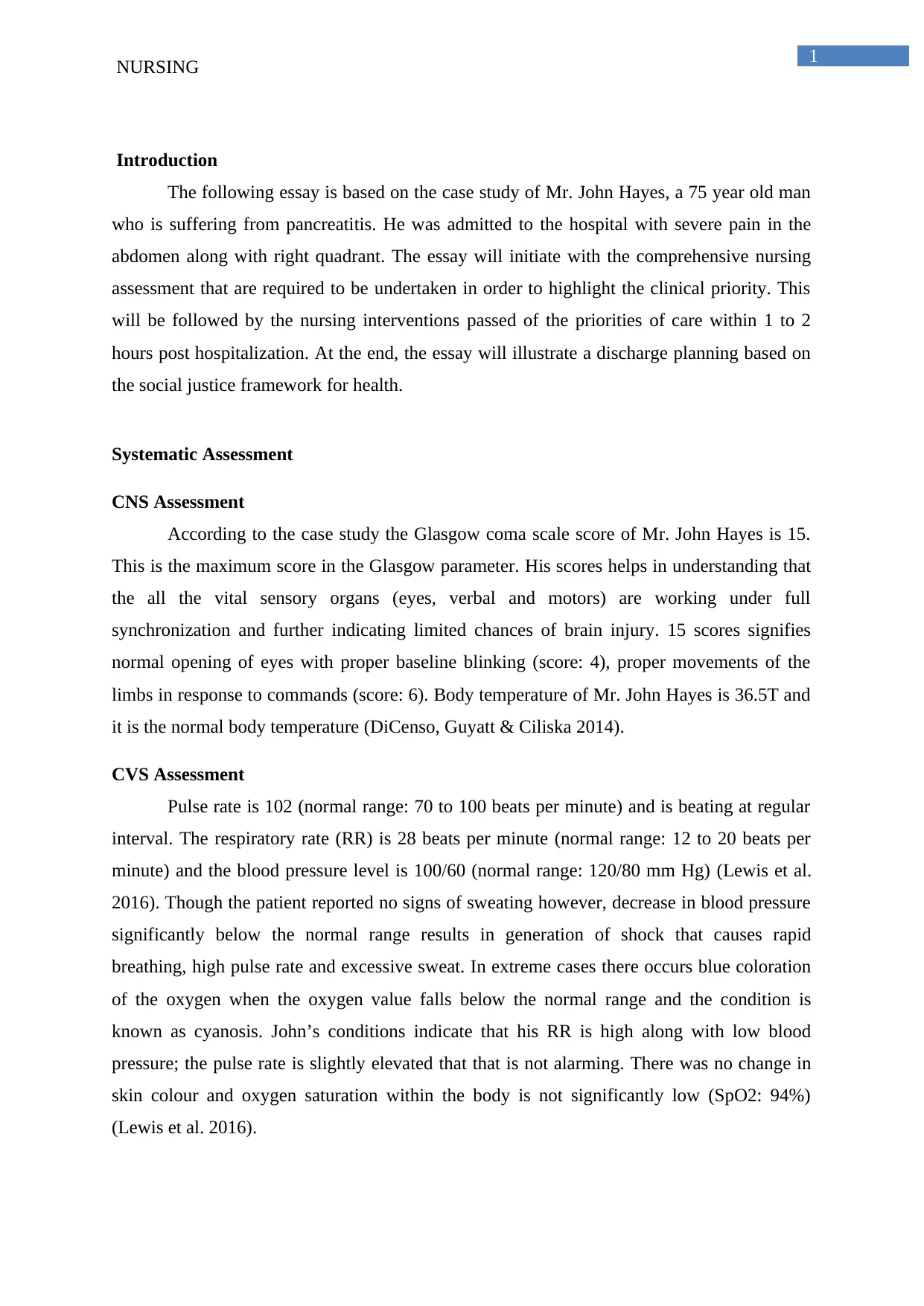
1
NURSING
Introduction
The following essay is based on the case study of Mr. John Hayes, a 75 year old man
who is suffering from pancreatitis. He was admitted to the hospital with severe pain in the
abdomen along with right quadrant. The essay will initiate with the comprehensive nursing
assessment that are required to be undertaken in order to highlight the clinical priority. This
will be followed by the nursing interventions passed of the priorities of care within 1 to 2
hours post hospitalization. At the end, the essay will illustrate a discharge planning based on
the social justice framework for health.
Systematic Assessment
CNS Assessment
According to the case study the Glasgow coma scale score of Mr. John Hayes is 15.
This is the maximum score in the Glasgow parameter. His scores helps in understanding that
the all the vital sensory organs (eyes, verbal and motors) are working under full
synchronization and further indicating limited chances of brain injury. 15 scores signifies
normal opening of eyes with proper baseline blinking (score: 4), proper movements of the
limbs in response to commands (score: 6). Body temperature of Mr. John Hayes is 36.5T and
it is the normal body temperature (DiCenso, Guyatt & Ciliska 2014).
CVS Assessment
Pulse rate is 102 (normal range: 70 to 100 beats per minute) and is beating at regular
interval. The respiratory rate (RR) is 28 beats per minute (normal range: 12 to 20 beats per
minute) and the blood pressure level is 100/60 (normal range: 120/80 mm Hg) (Lewis et al.
2016). Though the patient reported no signs of sweating however, decrease in blood pressure
significantly below the normal range results in generation of shock that causes rapid
breathing, high pulse rate and excessive sweat. In extreme cases there occurs blue coloration
of the oxygen when the oxygen value falls below the normal range and the condition is
known as cyanosis. John’s conditions indicate that his RR is high along with low blood
pressure; the pulse rate is slightly elevated that that is not alarming. There was no change in
skin colour and oxygen saturation within the body is not significantly low (SpO2: 94%)
(Lewis et al. 2016).
NURSING
Introduction
The following essay is based on the case study of Mr. John Hayes, a 75 year old man
who is suffering from pancreatitis. He was admitted to the hospital with severe pain in the
abdomen along with right quadrant. The essay will initiate with the comprehensive nursing
assessment that are required to be undertaken in order to highlight the clinical priority. This
will be followed by the nursing interventions passed of the priorities of care within 1 to 2
hours post hospitalization. At the end, the essay will illustrate a discharge planning based on
the social justice framework for health.
Systematic Assessment
CNS Assessment
According to the case study the Glasgow coma scale score of Mr. John Hayes is 15.
This is the maximum score in the Glasgow parameter. His scores helps in understanding that
the all the vital sensory organs (eyes, verbal and motors) are working under full
synchronization and further indicating limited chances of brain injury. 15 scores signifies
normal opening of eyes with proper baseline blinking (score: 4), proper movements of the
limbs in response to commands (score: 6). Body temperature of Mr. John Hayes is 36.5T and
it is the normal body temperature (DiCenso, Guyatt & Ciliska 2014).
CVS Assessment
Pulse rate is 102 (normal range: 70 to 100 beats per minute) and is beating at regular
interval. The respiratory rate (RR) is 28 beats per minute (normal range: 12 to 20 beats per
minute) and the blood pressure level is 100/60 (normal range: 120/80 mm Hg) (Lewis et al.
2016). Though the patient reported no signs of sweating however, decrease in blood pressure
significantly below the normal range results in generation of shock that causes rapid
breathing, high pulse rate and excessive sweat. In extreme cases there occurs blue coloration
of the oxygen when the oxygen value falls below the normal range and the condition is
known as cyanosis. John’s conditions indicate that his RR is high along with low blood
pressure; the pulse rate is slightly elevated that that is not alarming. There was no change in
skin colour and oxygen saturation within the body is not significantly low (SpO2: 94%)
(Lewis et al. 2016).
Secure Best Marks with AI Grader
Need help grading? Try our AI Grader for instant feedback on your assignments.

2
NURSING
RESP Assessment
Inspection: High respiratory rate and this is indicated with laboured breathing. SpO2
is 94% indicating normal oxygen saturation. John has past illness of pulmonary embolus (20
years ago at the age of 55).
Palpation: The measurement of pain in done with the help of the PQRST framework
Provocation (P): indicates that the pain is in the abdominal area. There is no reported cases of
rib fracture at the time of admission
Quality (Q): The pain is distressing in nature as indicated by the facial expression
Region (R): Upper right quadrant of the abdomen that is radiating to the back
Severity (S): The pain severity is 9 out of 10 thus indicating severe pain with
not signs of slowing down
Time (T): The sensation of pain stated after the dinner (1800 hours) and after 2
hours (2000 hours) he was admitted to the emergency department of the
hospital. He has chops and vegetables in the dinner.
Percussion: No wheezing sound while breathing
Ausculation: No difference in the breathing sound, He is not suffering from
severe dyspnoea (Lewis et al. 2016)
ABDO Assessment
a. Inspection: No scare is the abdomen. Abdomen is distended and patient showed
signs of nausea along with vomiting tendencies
b. Ausculation: Pain is in the upper right quadrant of the abdomen and thus might be a
sign of gall stones. However, this does not rule out the chances of pancreatitis. There
was no hyper or hypo bowel sounds
c. Percussion: Gas sounds is present (tympanic sound) along with abdominal
distension
d. Palpation: Pain score is 9 out of 10
NURSING
RESP Assessment
Inspection: High respiratory rate and this is indicated with laboured breathing. SpO2
is 94% indicating normal oxygen saturation. John has past illness of pulmonary embolus (20
years ago at the age of 55).
Palpation: The measurement of pain in done with the help of the PQRST framework
Provocation (P): indicates that the pain is in the abdominal area. There is no reported cases of
rib fracture at the time of admission
Quality (Q): The pain is distressing in nature as indicated by the facial expression
Region (R): Upper right quadrant of the abdomen that is radiating to the back
Severity (S): The pain severity is 9 out of 10 thus indicating severe pain with
not signs of slowing down
Time (T): The sensation of pain stated after the dinner (1800 hours) and after 2
hours (2000 hours) he was admitted to the emergency department of the
hospital. He has chops and vegetables in the dinner.
Percussion: No wheezing sound while breathing
Ausculation: No difference in the breathing sound, He is not suffering from
severe dyspnoea (Lewis et al. 2016)
ABDO Assessment
a. Inspection: No scare is the abdomen. Abdomen is distended and patient showed
signs of nausea along with vomiting tendencies
b. Ausculation: Pain is in the upper right quadrant of the abdomen and thus might be a
sign of gall stones. However, this does not rule out the chances of pancreatitis. There
was no hyper or hypo bowel sounds
c. Percussion: Gas sounds is present (tympanic sound) along with abdominal
distension
d. Palpation: Pain score is 9 out of 10
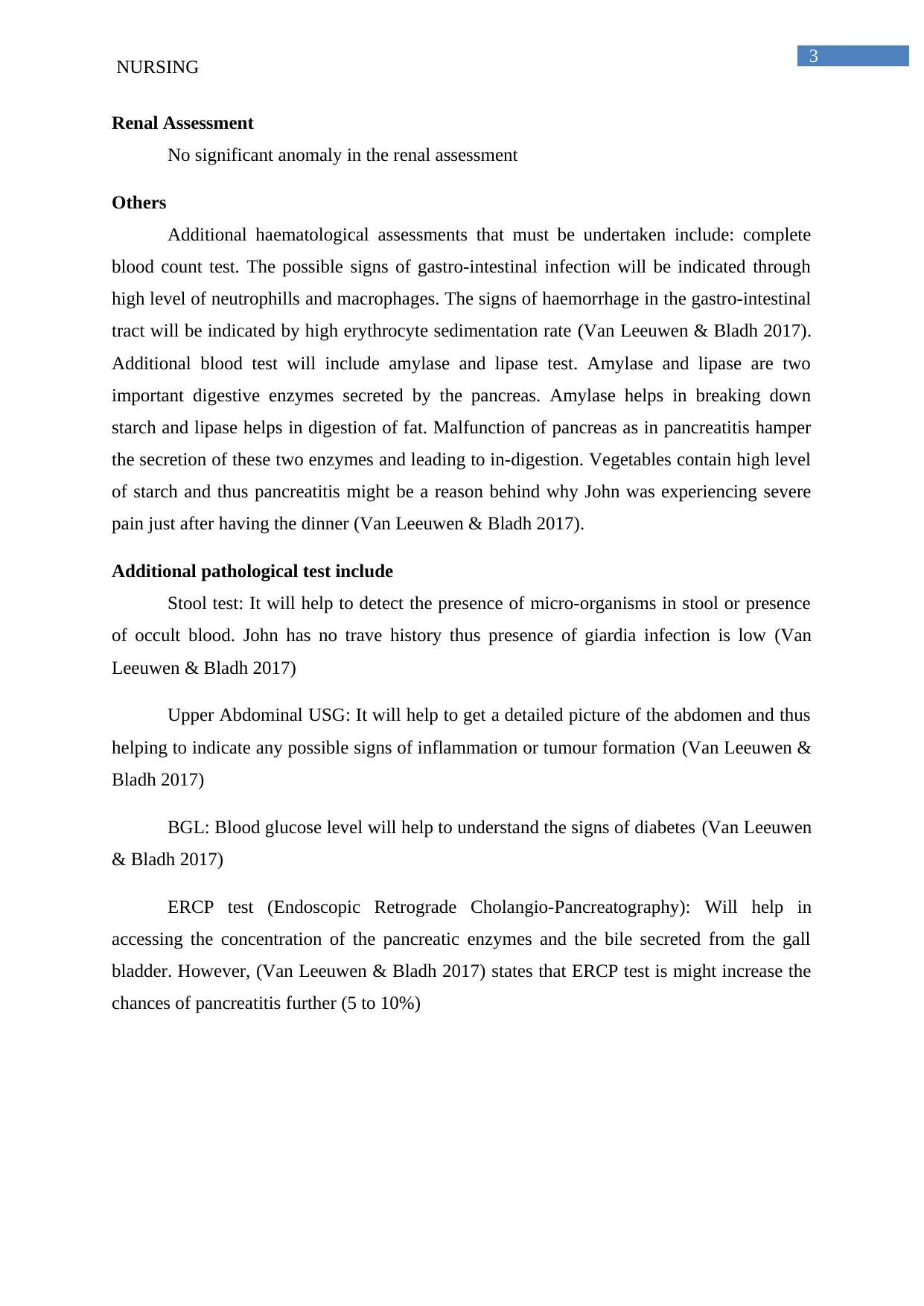
3
NURSING
Renal Assessment
No significant anomaly in the renal assessment
Others
Additional haematological assessments that must be undertaken include: complete
blood count test. The possible signs of gastro-intestinal infection will be indicated through
high level of neutrophills and macrophages. The signs of haemorrhage in the gastro-intestinal
tract will be indicated by high erythrocyte sedimentation rate (Van Leeuwen & Bladh 2017).
Additional blood test will include amylase and lipase test. Amylase and lipase are two
important digestive enzymes secreted by the pancreas. Amylase helps in breaking down
starch and lipase helps in digestion of fat. Malfunction of pancreas as in pancreatitis hamper
the secretion of these two enzymes and leading to in-digestion. Vegetables contain high level
of starch and thus pancreatitis might be a reason behind why John was experiencing severe
pain just after having the dinner (Van Leeuwen & Bladh 2017).
Additional pathological test include
Stool test: It will help to detect the presence of micro-organisms in stool or presence
of occult blood. John has no trave history thus presence of giardia infection is low (Van
Leeuwen & Bladh 2017)
Upper Abdominal USG: It will help to get a detailed picture of the abdomen and thus
helping to indicate any possible signs of inflammation or tumour formation (Van Leeuwen &
Bladh 2017)
BGL: Blood glucose level will help to understand the signs of diabetes (Van Leeuwen
& Bladh 2017)
ERCP test (Endoscopic Retrograde Cholangio-Pancreatography): Will help in
accessing the concentration of the pancreatic enzymes and the bile secreted from the gall
bladder. However, (Van Leeuwen & Bladh 2017) states that ERCP test is might increase the
chances of pancreatitis further (5 to 10%)
NURSING
Renal Assessment
No significant anomaly in the renal assessment
Others
Additional haematological assessments that must be undertaken include: complete
blood count test. The possible signs of gastro-intestinal infection will be indicated through
high level of neutrophills and macrophages. The signs of haemorrhage in the gastro-intestinal
tract will be indicated by high erythrocyte sedimentation rate (Van Leeuwen & Bladh 2017).
Additional blood test will include amylase and lipase test. Amylase and lipase are two
important digestive enzymes secreted by the pancreas. Amylase helps in breaking down
starch and lipase helps in digestion of fat. Malfunction of pancreas as in pancreatitis hamper
the secretion of these two enzymes and leading to in-digestion. Vegetables contain high level
of starch and thus pancreatitis might be a reason behind why John was experiencing severe
pain just after having the dinner (Van Leeuwen & Bladh 2017).
Additional pathological test include
Stool test: It will help to detect the presence of micro-organisms in stool or presence
of occult blood. John has no trave history thus presence of giardia infection is low (Van
Leeuwen & Bladh 2017)
Upper Abdominal USG: It will help to get a detailed picture of the abdomen and thus
helping to indicate any possible signs of inflammation or tumour formation (Van Leeuwen &
Bladh 2017)
BGL: Blood glucose level will help to understand the signs of diabetes (Van Leeuwen
& Bladh 2017)
ERCP test (Endoscopic Retrograde Cholangio-Pancreatography): Will help in
accessing the concentration of the pancreatic enzymes and the bile secreted from the gall
bladder. However, (Van Leeuwen & Bladh 2017) states that ERCP test is might increase the
chances of pancreatitis further (5 to 10%)
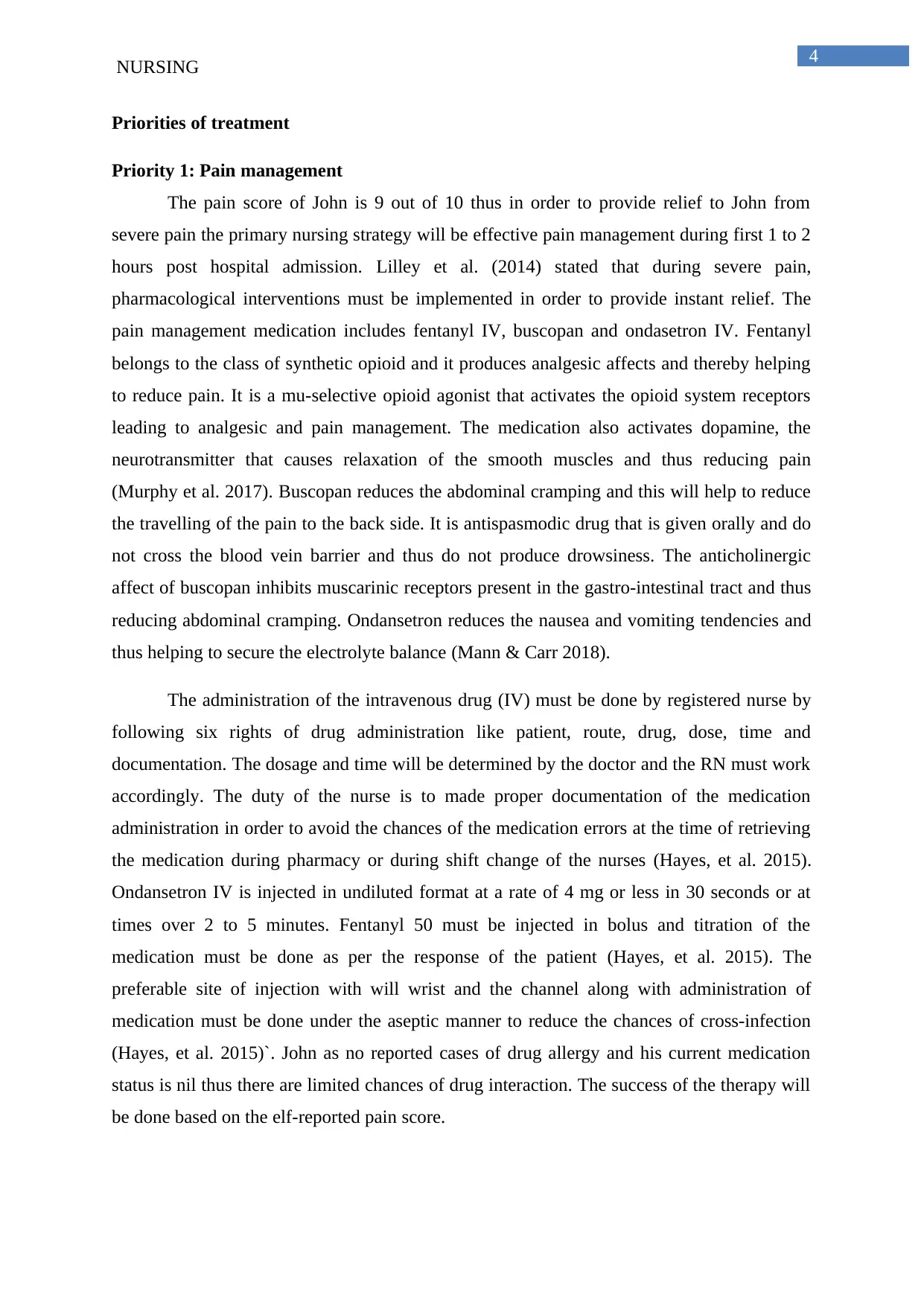
4
NURSING
Priorities of treatment
Priority 1: Pain management
The pain score of John is 9 out of 10 thus in order to provide relief to John from
severe pain the primary nursing strategy will be effective pain management during first 1 to 2
hours post hospital admission. Lilley et al. (2014) stated that during severe pain,
pharmacological interventions must be implemented in order to provide instant relief. The
pain management medication includes fentanyl IV, buscopan and ondasetron IV. Fentanyl
belongs to the class of synthetic opioid and it produces analgesic affects and thereby helping
to reduce pain. It is a mu-selective opioid agonist that activates the opioid system receptors
leading to analgesic and pain management. The medication also activates dopamine, the
neurotransmitter that causes relaxation of the smooth muscles and thus reducing pain
(Murphy et al. 2017). Buscopan reduces the abdominal cramping and this will help to reduce
the travelling of the pain to the back side. It is antispasmodic drug that is given orally and do
not cross the blood vein barrier and thus do not produce drowsiness. The anticholinergic
affect of buscopan inhibits muscarinic receptors present in the gastro-intestinal tract and thus
reducing abdominal cramping. Ondansetron reduces the nausea and vomiting tendencies and
thus helping to secure the electrolyte balance (Mann & Carr 2018).
The administration of the intravenous drug (IV) must be done by registered nurse by
following six rights of drug administration like patient, route, drug, dose, time and
documentation. The dosage and time will be determined by the doctor and the RN must work
accordingly. The duty of the nurse is to made proper documentation of the medication
administration in order to avoid the chances of the medication errors at the time of retrieving
the medication during pharmacy or during shift change of the nurses (Hayes, et al. 2015).
Ondansetron IV is injected in undiluted format at a rate of 4 mg or less in 30 seconds or at
times over 2 to 5 minutes. Fentanyl 50 must be injected in bolus and titration of the
medication must be done as per the response of the patient (Hayes, et al. 2015). The
preferable site of injection with will wrist and the channel along with administration of
medication must be done under the aseptic manner to reduce the chances of cross-infection
(Hayes, et al. 2015)`. John as no reported cases of drug allergy and his current medication
status is nil thus there are limited chances of drug interaction. The success of the therapy will
be done based on the elf-reported pain score.
NURSING
Priorities of treatment
Priority 1: Pain management
The pain score of John is 9 out of 10 thus in order to provide relief to John from
severe pain the primary nursing strategy will be effective pain management during first 1 to 2
hours post hospital admission. Lilley et al. (2014) stated that during severe pain,
pharmacological interventions must be implemented in order to provide instant relief. The
pain management medication includes fentanyl IV, buscopan and ondasetron IV. Fentanyl
belongs to the class of synthetic opioid and it produces analgesic affects and thereby helping
to reduce pain. It is a mu-selective opioid agonist that activates the opioid system receptors
leading to analgesic and pain management. The medication also activates dopamine, the
neurotransmitter that causes relaxation of the smooth muscles and thus reducing pain
(Murphy et al. 2017). Buscopan reduces the abdominal cramping and this will help to reduce
the travelling of the pain to the back side. It is antispasmodic drug that is given orally and do
not cross the blood vein barrier and thus do not produce drowsiness. The anticholinergic
affect of buscopan inhibits muscarinic receptors present in the gastro-intestinal tract and thus
reducing abdominal cramping. Ondansetron reduces the nausea and vomiting tendencies and
thus helping to secure the electrolyte balance (Mann & Carr 2018).
The administration of the intravenous drug (IV) must be done by registered nurse by
following six rights of drug administration like patient, route, drug, dose, time and
documentation. The dosage and time will be determined by the doctor and the RN must work
accordingly. The duty of the nurse is to made proper documentation of the medication
administration in order to avoid the chances of the medication errors at the time of retrieving
the medication during pharmacy or during shift change of the nurses (Hayes, et al. 2015).
Ondansetron IV is injected in undiluted format at a rate of 4 mg or less in 30 seconds or at
times over 2 to 5 minutes. Fentanyl 50 must be injected in bolus and titration of the
medication must be done as per the response of the patient (Hayes, et al. 2015). The
preferable site of injection with will wrist and the channel along with administration of
medication must be done under the aseptic manner to reduce the chances of cross-infection
(Hayes, et al. 2015)`. John as no reported cases of drug allergy and his current medication
status is nil thus there are limited chances of drug interaction. The success of the therapy will
be done based on the elf-reported pain score.
Secure Best Marks with AI Grader
Need help grading? Try our AI Grader for instant feedback on your assignments.
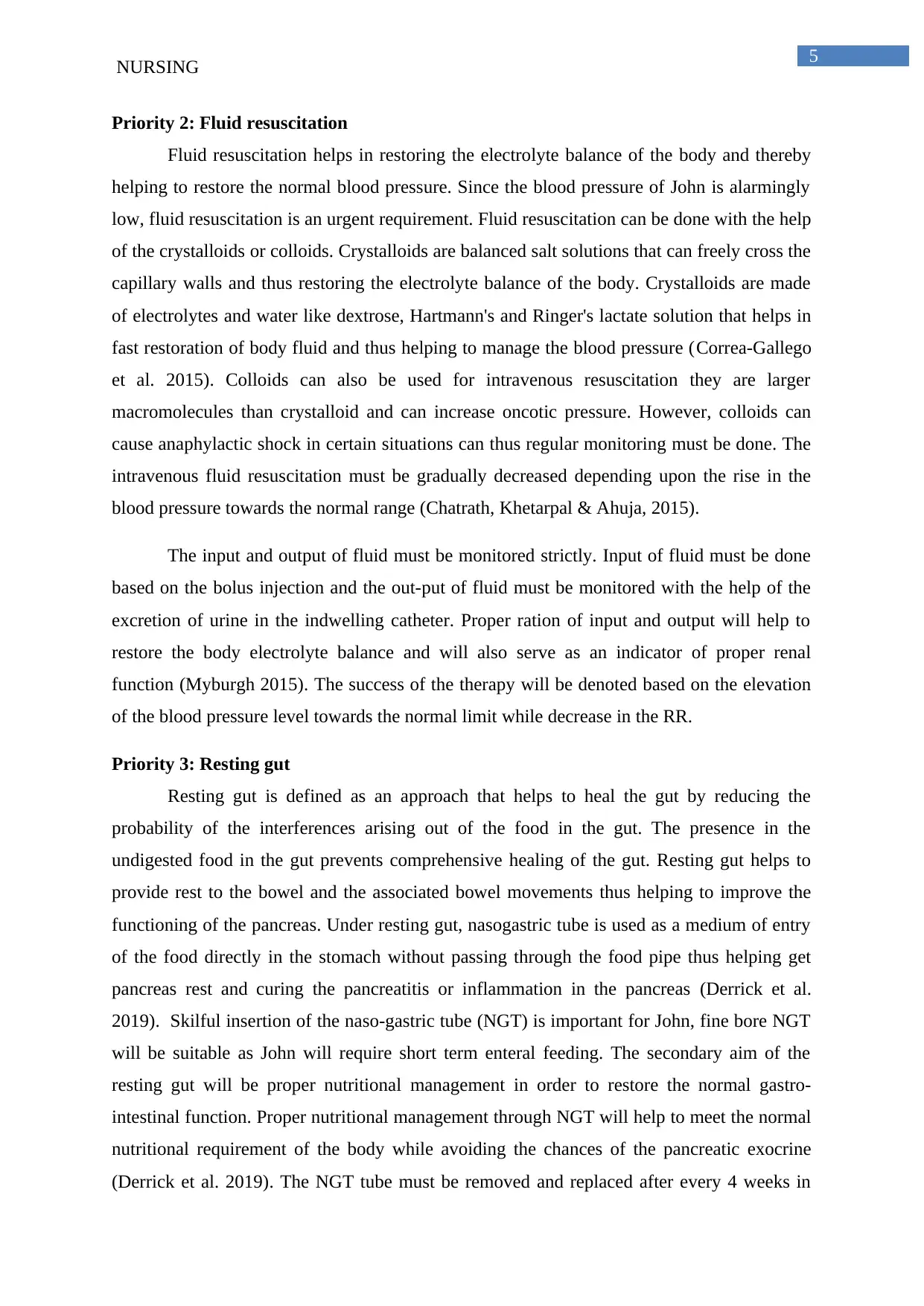
5
NURSING
Priority 2: Fluid resuscitation
Fluid resuscitation helps in restoring the electrolyte balance of the body and thereby
helping to restore the normal blood pressure. Since the blood pressure of John is alarmingly
low, fluid resuscitation is an urgent requirement. Fluid resuscitation can be done with the help
of the crystalloids or colloids. Crystalloids are balanced salt solutions that can freely cross the
capillary walls and thus restoring the electrolyte balance of the body. Crystalloids are made
of electrolytes and water like dextrose, Hartmann's and Ringer's lactate solution that helps in
fast restoration of body fluid and thus helping to manage the blood pressure (Correa-Gallego
et al. 2015). Colloids can also be used for intravenous resuscitation they are larger
macromolecules than crystalloid and can increase oncotic pressure. However, colloids can
cause anaphylactic shock in certain situations can thus regular monitoring must be done. The
intravenous fluid resuscitation must be gradually decreased depending upon the rise in the
blood pressure towards the normal range (Chatrath, Khetarpal & Ahuja, 2015).
The input and output of fluid must be monitored strictly. Input of fluid must be done
based on the bolus injection and the out-put of fluid must be monitored with the help of the
excretion of urine in the indwelling catheter. Proper ration of input and output will help to
restore the body electrolyte balance and will also serve as an indicator of proper renal
function (Myburgh 2015). The success of the therapy will be denoted based on the elevation
of the blood pressure level towards the normal limit while decrease in the RR.
Priority 3: Resting gut
Resting gut is defined as an approach that helps to heal the gut by reducing the
probability of the interferences arising out of the food in the gut. The presence in the
undigested food in the gut prevents comprehensive healing of the gut. Resting gut helps to
provide rest to the bowel and the associated bowel movements thus helping to improve the
functioning of the pancreas. Under resting gut, nasogastric tube is used as a medium of entry
of the food directly in the stomach without passing through the food pipe thus helping get
pancreas rest and curing the pancreatitis or inflammation in the pancreas (Derrick et al.
2019). Skilful insertion of the naso-gastric tube (NGT) is important for John, fine bore NGT
will be suitable as John will require short term enteral feeding. The secondary aim of the
resting gut will be proper nutritional management in order to restore the normal gastro-
intestinal function. Proper nutritional management through NGT will help to meet the normal
nutritional requirement of the body while avoiding the chances of the pancreatic exocrine
(Derrick et al. 2019). The NGT tube must be removed and replaced after every 4 weeks in
NURSING
Priority 2: Fluid resuscitation
Fluid resuscitation helps in restoring the electrolyte balance of the body and thereby
helping to restore the normal blood pressure. Since the blood pressure of John is alarmingly
low, fluid resuscitation is an urgent requirement. Fluid resuscitation can be done with the help
of the crystalloids or colloids. Crystalloids are balanced salt solutions that can freely cross the
capillary walls and thus restoring the electrolyte balance of the body. Crystalloids are made
of electrolytes and water like dextrose, Hartmann's and Ringer's lactate solution that helps in
fast restoration of body fluid and thus helping to manage the blood pressure (Correa-Gallego
et al. 2015). Colloids can also be used for intravenous resuscitation they are larger
macromolecules than crystalloid and can increase oncotic pressure. However, colloids can
cause anaphylactic shock in certain situations can thus regular monitoring must be done. The
intravenous fluid resuscitation must be gradually decreased depending upon the rise in the
blood pressure towards the normal range (Chatrath, Khetarpal & Ahuja, 2015).
The input and output of fluid must be monitored strictly. Input of fluid must be done
based on the bolus injection and the out-put of fluid must be monitored with the help of the
excretion of urine in the indwelling catheter. Proper ration of input and output will help to
restore the body electrolyte balance and will also serve as an indicator of proper renal
function (Myburgh 2015). The success of the therapy will be denoted based on the elevation
of the blood pressure level towards the normal limit while decrease in the RR.
Priority 3: Resting gut
Resting gut is defined as an approach that helps to heal the gut by reducing the
probability of the interferences arising out of the food in the gut. The presence in the
undigested food in the gut prevents comprehensive healing of the gut. Resting gut helps to
provide rest to the bowel and the associated bowel movements thus helping to improve the
functioning of the pancreas. Under resting gut, nasogastric tube is used as a medium of entry
of the food directly in the stomach without passing through the food pipe thus helping get
pancreas rest and curing the pancreatitis or inflammation in the pancreas (Derrick et al.
2019). Skilful insertion of the naso-gastric tube (NGT) is important for John, fine bore NGT
will be suitable as John will require short term enteral feeding. The secondary aim of the
resting gut will be proper nutritional management in order to restore the normal gastro-
intestinal function. Proper nutritional management through NGT will help to meet the normal
nutritional requirement of the body while avoiding the chances of the pancreatic exocrine
(Derrick et al. 2019). The NGT tube must be removed and replaced after every 4 weeks in
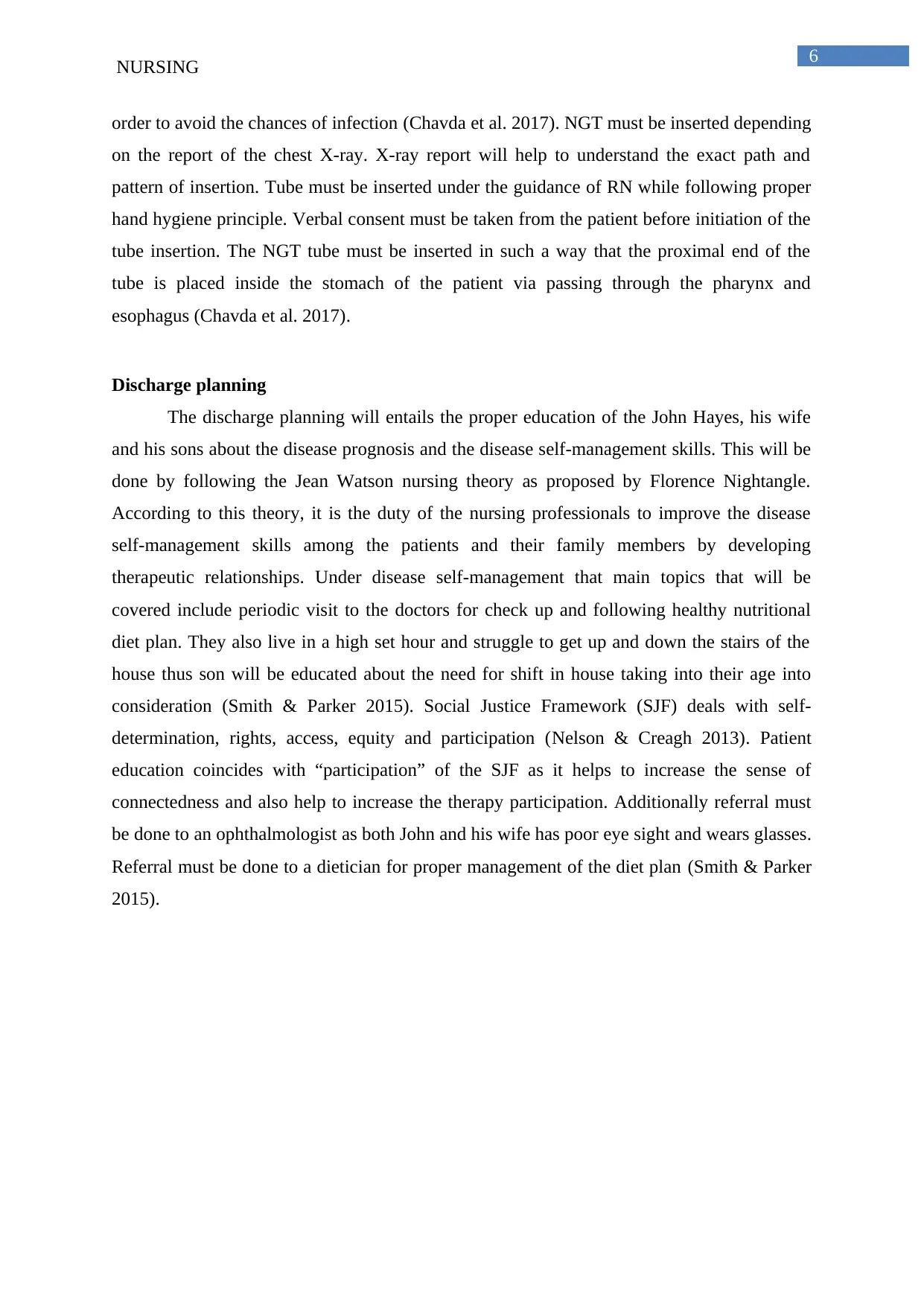
6
NURSING
order to avoid the chances of infection (Chavda et al. 2017). NGT must be inserted depending
on the report of the chest X-ray. X-ray report will help to understand the exact path and
pattern of insertion. Tube must be inserted under the guidance of RN while following proper
hand hygiene principle. Verbal consent must be taken from the patient before initiation of the
tube insertion. The NGT tube must be inserted in such a way that the proximal end of the
tube is placed inside the stomach of the patient via passing through the pharynx and
esophagus (Chavda et al. 2017).
Discharge planning
The discharge planning will entails the proper education of the John Hayes, his wife
and his sons about the disease prognosis and the disease self-management skills. This will be
done by following the Jean Watson nursing theory as proposed by Florence Nightangle.
According to this theory, it is the duty of the nursing professionals to improve the disease
self-management skills among the patients and their family members by developing
therapeutic relationships. Under disease self-management that main topics that will be
covered include periodic visit to the doctors for check up and following healthy nutritional
diet plan. They also live in a high set hour and struggle to get up and down the stairs of the
house thus son will be educated about the need for shift in house taking into their age into
consideration (Smith & Parker 2015). Social Justice Framework (SJF) deals with self-
determination, rights, access, equity and participation (Nelson & Creagh 2013). Patient
education coincides with “participation” of the SJF as it helps to increase the sense of
connectedness and also help to increase the therapy participation. Additionally referral must
be done to an ophthalmologist as both John and his wife has poor eye sight and wears glasses.
Referral must be done to a dietician for proper management of the diet plan (Smith & Parker
2015).
NURSING
order to avoid the chances of infection (Chavda et al. 2017). NGT must be inserted depending
on the report of the chest X-ray. X-ray report will help to understand the exact path and
pattern of insertion. Tube must be inserted under the guidance of RN while following proper
hand hygiene principle. Verbal consent must be taken from the patient before initiation of the
tube insertion. The NGT tube must be inserted in such a way that the proximal end of the
tube is placed inside the stomach of the patient via passing through the pharynx and
esophagus (Chavda et al. 2017).
Discharge planning
The discharge planning will entails the proper education of the John Hayes, his wife
and his sons about the disease prognosis and the disease self-management skills. This will be
done by following the Jean Watson nursing theory as proposed by Florence Nightangle.
According to this theory, it is the duty of the nursing professionals to improve the disease
self-management skills among the patients and their family members by developing
therapeutic relationships. Under disease self-management that main topics that will be
covered include periodic visit to the doctors for check up and following healthy nutritional
diet plan. They also live in a high set hour and struggle to get up and down the stairs of the
house thus son will be educated about the need for shift in house taking into their age into
consideration (Smith & Parker 2015). Social Justice Framework (SJF) deals with self-
determination, rights, access, equity and participation (Nelson & Creagh 2013). Patient
education coincides with “participation” of the SJF as it helps to increase the sense of
connectedness and also help to increase the therapy participation. Additionally referral must
be done to an ophthalmologist as both John and his wife has poor eye sight and wears glasses.
Referral must be done to a dietician for proper management of the diet plan (Smith & Parker
2015).
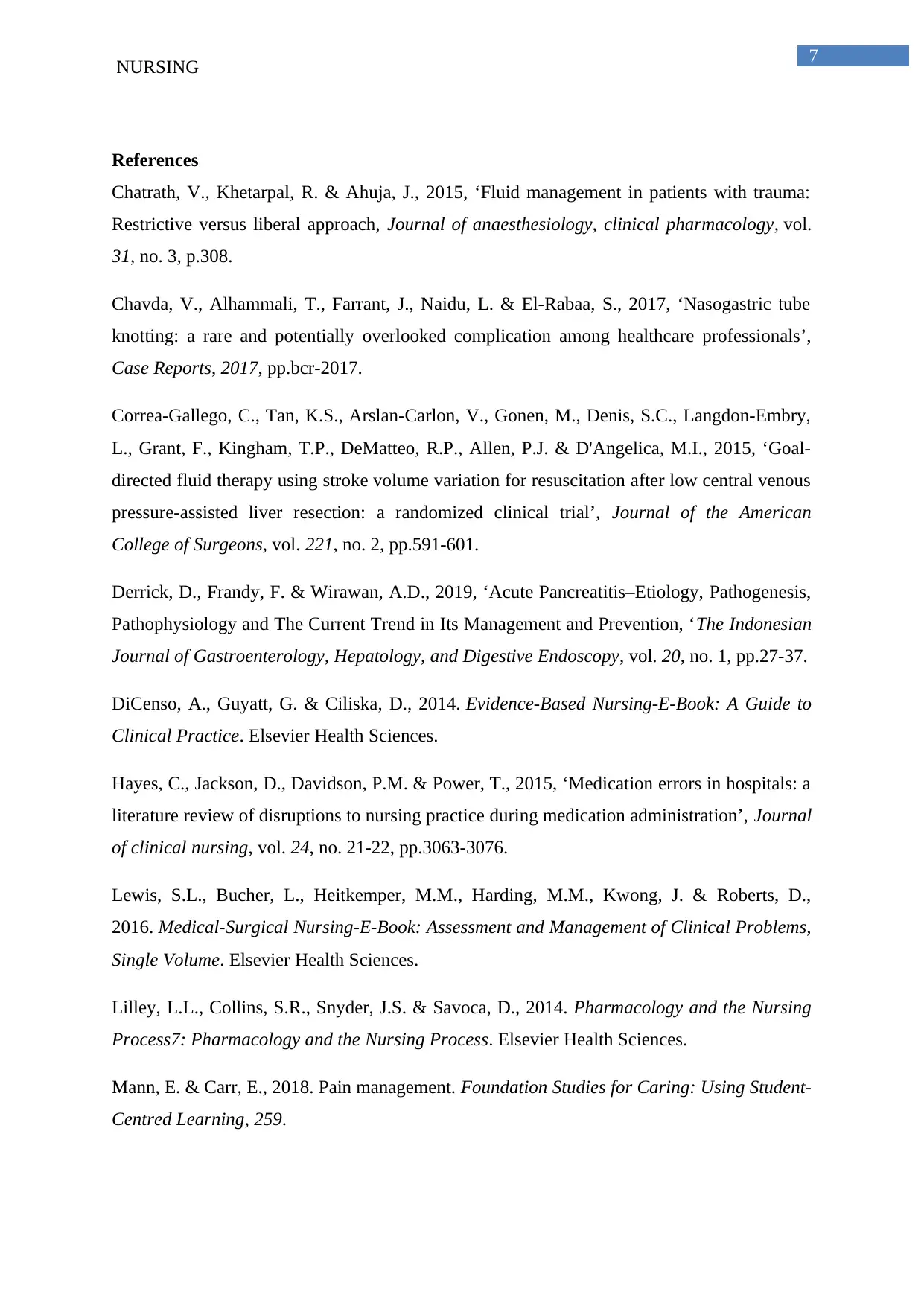
7
NURSING
References
Chatrath, V., Khetarpal, R. & Ahuja, J., 2015, ‘Fluid management in patients with trauma:
Restrictive versus liberal approach, Journal of anaesthesiology, clinical pharmacology, vol.
31, no. 3, p.308.
Chavda, V., Alhammali, T., Farrant, J., Naidu, L. & El-Rabaa, S., 2017, ‘Nasogastric tube
knotting: a rare and potentially overlooked complication among healthcare professionals’,
Case Reports, 2017, pp.bcr-2017.
Correa-Gallego, C., Tan, K.S., Arslan-Carlon, V., Gonen, M., Denis, S.C., Langdon-Embry,
L., Grant, F., Kingham, T.P., DeMatteo, R.P., Allen, P.J. & D'Angelica, M.I., 2015, ‘Goal-
directed fluid therapy using stroke volume variation for resuscitation after low central venous
pressure-assisted liver resection: a randomized clinical trial’, Journal of the American
College of Surgeons, vol. 221, no. 2, pp.591-601.
Derrick, D., Frandy, F. & Wirawan, A.D., 2019, ‘Acute Pancreatitis–Etiology, Pathogenesis,
Pathophysiology and The Current Trend in Its Management and Prevention, ‘The Indonesian
Journal of Gastroenterology, Hepatology, and Digestive Endoscopy, vol. 20, no. 1, pp.27-37.
DiCenso, A., Guyatt, G. & Ciliska, D., 2014. Evidence-Based Nursing-E-Book: A Guide to
Clinical Practice. Elsevier Health Sciences.
Hayes, C., Jackson, D., Davidson, P.M. & Power, T., 2015, ‘Medication errors in hospitals: a
literature review of disruptions to nursing practice during medication administration’, Journal
of clinical nursing, vol. 24, no. 21-22, pp.3063-3076.
Lewis, S.L., Bucher, L., Heitkemper, M.M., Harding, M.M., Kwong, J. & Roberts, D.,
2016. Medical-Surgical Nursing-E-Book: Assessment and Management of Clinical Problems,
Single Volume. Elsevier Health Sciences.
Lilley, L.L., Collins, S.R., Snyder, J.S. & Savoca, D., 2014. Pharmacology and the Nursing
Process7: Pharmacology and the Nursing Process. Elsevier Health Sciences.
Mann, E. & Carr, E., 2018. Pain management. Foundation Studies for Caring: Using Student-
Centred Learning, 259.
NURSING
References
Chatrath, V., Khetarpal, R. & Ahuja, J., 2015, ‘Fluid management in patients with trauma:
Restrictive versus liberal approach, Journal of anaesthesiology, clinical pharmacology, vol.
31, no. 3, p.308.
Chavda, V., Alhammali, T., Farrant, J., Naidu, L. & El-Rabaa, S., 2017, ‘Nasogastric tube
knotting: a rare and potentially overlooked complication among healthcare professionals’,
Case Reports, 2017, pp.bcr-2017.
Correa-Gallego, C., Tan, K.S., Arslan-Carlon, V., Gonen, M., Denis, S.C., Langdon-Embry,
L., Grant, F., Kingham, T.P., DeMatteo, R.P., Allen, P.J. & D'Angelica, M.I., 2015, ‘Goal-
directed fluid therapy using stroke volume variation for resuscitation after low central venous
pressure-assisted liver resection: a randomized clinical trial’, Journal of the American
College of Surgeons, vol. 221, no. 2, pp.591-601.
Derrick, D., Frandy, F. & Wirawan, A.D., 2019, ‘Acute Pancreatitis–Etiology, Pathogenesis,
Pathophysiology and The Current Trend in Its Management and Prevention, ‘The Indonesian
Journal of Gastroenterology, Hepatology, and Digestive Endoscopy, vol. 20, no. 1, pp.27-37.
DiCenso, A., Guyatt, G. & Ciliska, D., 2014. Evidence-Based Nursing-E-Book: A Guide to
Clinical Practice. Elsevier Health Sciences.
Hayes, C., Jackson, D., Davidson, P.M. & Power, T., 2015, ‘Medication errors in hospitals: a
literature review of disruptions to nursing practice during medication administration’, Journal
of clinical nursing, vol. 24, no. 21-22, pp.3063-3076.
Lewis, S.L., Bucher, L., Heitkemper, M.M., Harding, M.M., Kwong, J. & Roberts, D.,
2016. Medical-Surgical Nursing-E-Book: Assessment and Management of Clinical Problems,
Single Volume. Elsevier Health Sciences.
Lilley, L.L., Collins, S.R., Snyder, J.S. & Savoca, D., 2014. Pharmacology and the Nursing
Process7: Pharmacology and the Nursing Process. Elsevier Health Sciences.
Mann, E. & Carr, E., 2018. Pain management. Foundation Studies for Caring: Using Student-
Centred Learning, 259.
Paraphrase This Document
Need a fresh take? Get an instant paraphrase of this document with our AI Paraphraser
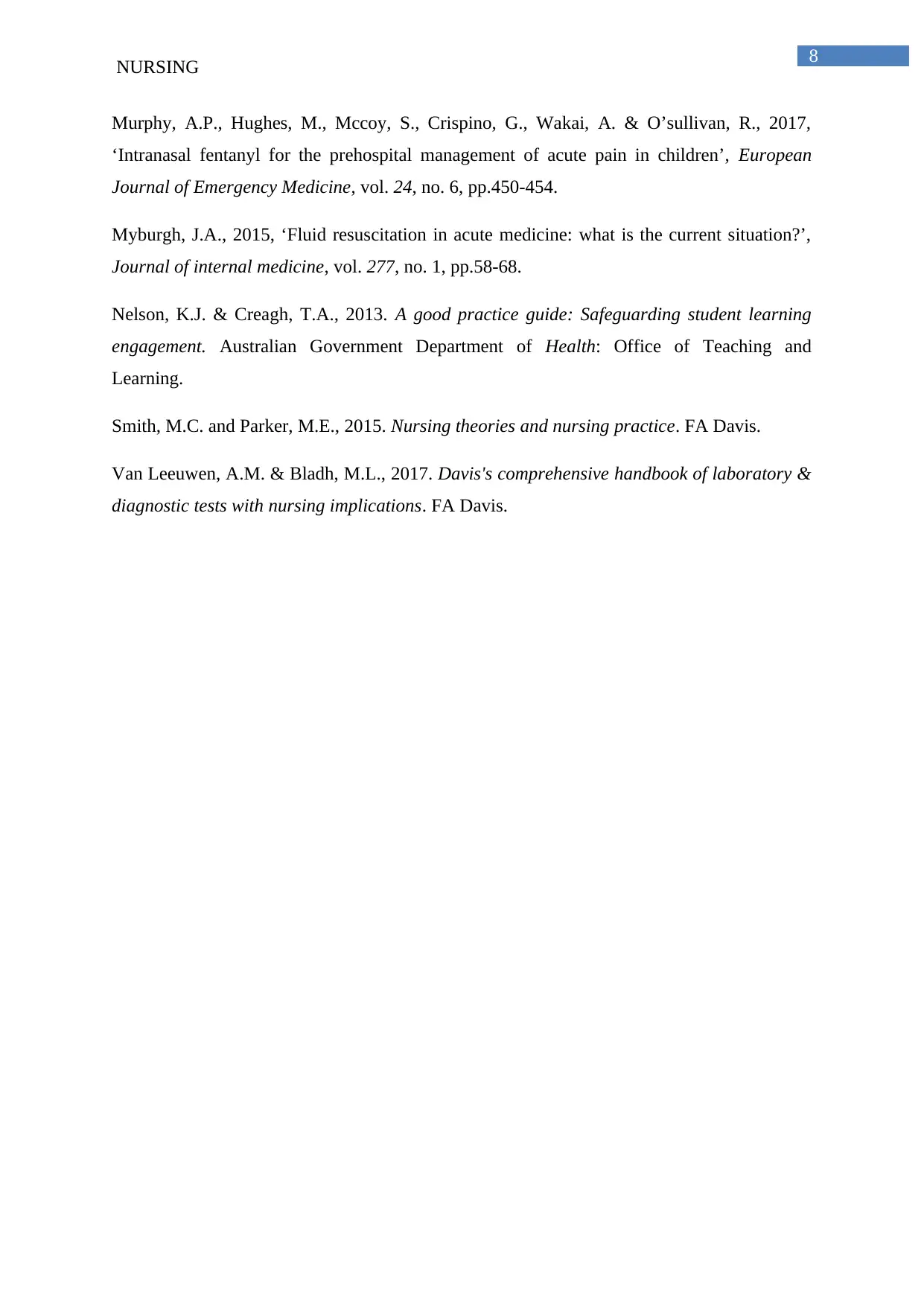
8
NURSING
Murphy, A.P., Hughes, M., Mccoy, S., Crispino, G., Wakai, A. & O’sullivan, R., 2017,
‘Intranasal fentanyl for the prehospital management of acute pain in children’, European
Journal of Emergency Medicine, vol. 24, no. 6, pp.450-454.
Myburgh, J.A., 2015, ‘Fluid resuscitation in acute medicine: what is the current situation?’,
Journal of internal medicine, vol. 277, no. 1, pp.58-68.
Nelson, K.J. & Creagh, T.A., 2013. A good practice guide: Safeguarding student learning
engagement. Australian Government Department of Health: Office of Teaching and
Learning.
Smith, M.C. and Parker, M.E., 2015. Nursing theories and nursing practice. FA Davis.
Van Leeuwen, A.M. & Bladh, M.L., 2017. Davis's comprehensive handbook of laboratory &
diagnostic tests with nursing implications. FA Davis.
NURSING
Murphy, A.P., Hughes, M., Mccoy, S., Crispino, G., Wakai, A. & O’sullivan, R., 2017,
‘Intranasal fentanyl for the prehospital management of acute pain in children’, European
Journal of Emergency Medicine, vol. 24, no. 6, pp.450-454.
Myburgh, J.A., 2015, ‘Fluid resuscitation in acute medicine: what is the current situation?’,
Journal of internal medicine, vol. 277, no. 1, pp.58-68.
Nelson, K.J. & Creagh, T.A., 2013. A good practice guide: Safeguarding student learning
engagement. Australian Government Department of Health: Office of Teaching and
Learning.
Smith, M.C. and Parker, M.E., 2015. Nursing theories and nursing practice. FA Davis.
Van Leeuwen, A.M. & Bladh, M.L., 2017. Davis's comprehensive handbook of laboratory &
diagnostic tests with nursing implications. FA Davis.
1 out of 8
Related Documents
Your All-in-One AI-Powered Toolkit for Academic Success.
+13062052269
info@desklib.com
Available 24*7 on WhatsApp / Email
![[object Object]](/_next/static/media/star-bottom.7253800d.svg)
Unlock your academic potential
© 2024 | Zucol Services PVT LTD | All rights reserved.





